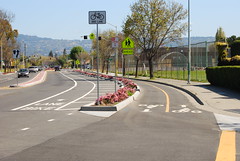The Promised Land
Via Lee Watkins on the Envision Baltimore e-list:
Image of new bike lanes on Fernside Boulevard in Alameda, California from Fragmentary Evidence.
Fragmentary Evidence concludes:
The fact is that it shouldn’t be so hard to remove a car lane and install a protected bike lane on a few well-chosen routes across all of our cities—all it takes is a few city officials who adopt this as a pet cause, and a small group of highly motivated citizens who work to mobilize support among the public, help come up with smart plans, and prod our cities to keep their promises. So maybe I’ll finally get down off my high bike and show up to one of the many meetings where people are working on the nuts and bolts of implementing these sorts of plans. If the last depression produced a legacy of bridges, parks and buildings which still enrich our lives 75 years later, why can’t this depression produce a legacy of bike paths, bike lanes and improved streetscapes that will enrich our own children, grandchildren, great-grandchildren and beyond?
Maybe that’s too much to hope for, but when one is feeling the excitement of new love, almost anything seems possible.
Lee also calls our attention to a school in San Jose, California where the police department says that the traffic pattern means that students cannot bicycle to school.
And to the public uproar in San Carlos, California, because an adjoining community, Belmont, has reduced the number of automobile lanes in various places, including in the vicinity of the Clarmont High School, to support bicycling.
See "Officials, residents vet traffic improvements around Carlmont High" and "Emergency changes proposed to loosen traffic jams around Carlmont High School in Belmont" from the Palo Alto Daily News.
I guarantee that without robust transportation plans, and strong elements on what the transportation plan (e.g., the Master Transportation Plan Adopted and Draft Elements from Arlington County Virginia) is supposed to do and the foundational philosophies (e.g., MTP Goals and Policies) which justify priorities and the resulting choices that are made, these kinds of conflicts will continue.
Labels: bicycling, transportation planning, urban design/placemaking




0 Comments:
Post a Comment
<< Home